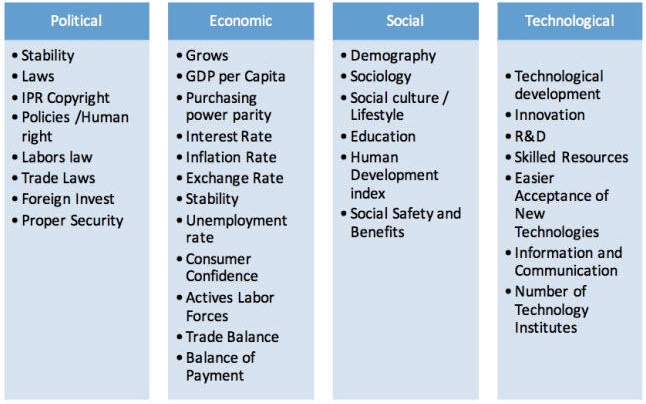Table of Contents
What is PEST Analysis?
Define Your Objectives.
Political Factors
Economic Factors
Social Factors
Technological Factors
Advantages & Disadvantages
How to Conduct a PEST Analysis
Examples of PEST Analysis
Conclusion
What is PEST Analysis?
PEST analysis is a strategic management tool used by organisations to identify and evaluate how the external environment – political, economic, social and technological forces – can affect their business operations.
By understanding these forces and their impact, businesses can make informed decisions that help them gain an edge over their competitors.

Image Source: WordStream
Define Your Objectives.
One of the keys to successful PEST analysis is to define your specific objectives. What strategies or changes do you wish to identify? Do you want to identify opportunities and threats? Are you trying to gain insights that will help inform new product launches, pricing or marketing strategies? Knowing what your end goal is can help make sure that the information you collect and analyse helps you achieve it.
PEST Analysis consists of four components:
Political Factors
Political factors are external to your business, but they can have a significant impact on your operations. Political factors include:
- Government policies and regulations
- Tax regulations
- Trade restrictions (tariffs)
- Political stability
Analyse the Political Environment.
To identify the major political forces in a particular industry, it’s important to consider both local and national contexts. Changes in government regulation or policy can have a direct impact on business operations as well as consumer behaviour. Understanding the legal and regulatory landscape of your industry can help you stay ahead of the competition and respond effectively too changes.
Analysing local politics, such as tax initiatives or elections, can also be beneficial for spotting opportunities or providing insights into consumer sentiment.
Economic Factors
- Economic growth
- Interest rates
- Exchange rates
- Inflation
Analyse the Economic Environment.
Economic conditions can have a major impact on industries and businesses. Examining certain economic factors such as GDP, inflation rate, unemployment rates, bank interest rates, and consumer sentiment can help you understand the current and potential future economic environment in which your business operates. Understanding how economic trends are shifting and how they might influence existing markets or create new opportunities can help you identify new strategies or adjust your existing plans to gain a competitive advantage.
Social Factors
- Demographics: The population of a country or region, including age, gender and income levels.
- Social trends: Trends in society that affect the business environment. For example, if there’s an increase in the number of single-person households or people working from home, this may have an impact on your business model.
- Lifestyle changes: Changes in lifestyle can affect demand for your product or service; for example if there’s more interest in organic food, then it might be worth researching how you could develop a new range for this market segment.
- Consumer preferences: Consumer preferences are often driven by media coverage (e.g., television advertising), social media posts etc., so keep track of what people are saying about your industry online!
Analyse the Social Environment.
It’s important to consider the culture and lifestyle of your target audience when conducting a PEST analysis. That includes things such as social values and attitudes, population demographics, consumer lifestyles, and preferences. Pay attention to consumer trend data that may signify changes in purchasing power or buying behavior. Also assess social concerns and effects of government policies or regulations that may impact your business decisions or strategies. All these elements provide insight into how you can better understand your consumers and help create effective marketing campaigns with maximum reach across various sectors of the economy.
Technological Factors
Technological factors are important because they can affect the growth of a company. For example, if you are considering purchasing a company and it has an R&D department that is not performing well, this could be a red flag for you. The same goes for automation or technology incentives; these may be signs that the company is using outdated methods to produce its products or services.
The access to technology factor refers to how easy it is for people within your industry to access new technologies as they become available on the market. If there are many barriers preventing them from doing so (like high costs), then this could affect how quickly innovation happens within your industry
Analyse the Technological Environment.
When it comes to creating a competitive advantage, technological analysis is the key. It involves studying technological trends, innovations or breakthroughs, the impact of automation on your business model and industry in general, how new technologies are being used by competitors and customers, and legal considerations related to technological advancements like patents and copyrights. In addition, assess the cost of investments associated with new technologies and review data from technology forecasters to help plan for future capabilities. By leveraging technology strategically for competitive advantage, businesses can stay ahead of their competition and succeed in today’s fast-paced market.
Advantages of PEST Analysis
- Identify potential opportunities & threats
- Monitor external environment
- Assist with decision making
Disadvantages of PEST Analysis
- Time consuming
- Overly complex
- Subjective information
- Not reliable
How to Conduct a PEST Analysis
To conduct a PEST analysis, you must first identify the relevant factors as outlined above. These are the issues that affect your business and its environment. You will then assign weights to each factor based on their impact on your business. Finally, analyse the data and make decisions based on what you have learned from this process.
Examples of PEST Analysis
PEST analysis is a useful tool for businesses to use when they are trying to determine the most effective ways they can compete in their industry. It’s also a great way for managers and executives to understand how different factors affect their company’s performance, as well as where they might be able to find opportunities for growth.
The following examples will help you better understand how PEST analysis works:
- Retail industry – The retail sector has been undergoing significant changes over the past decade due to the rise of online shopping, which has led many brick-and-mortar stores across North America (and around the world) into bankruptcy or near-bankruptcy status. Many retailers have responded by closing down locations and downsizing operations; others have tried diversifying their product offerings by adding services like grocery delivery services so that customers don’t have any reason not go through them anymore when looking for something specific like food items or clothing items that aren’t available locally anymore either because those stores closed down due too much competition from other businesses offering similar products at lower prices than what was being charged before this shift occurred within this industry segment!
Conclusion
PEST analysis is a useful tool for strategic planning. It can help companies identify potential opportunities and threats, as well as areas for improvement.
It’s important to conduct PEST analyses regularly so that you’re always aware of what’s happening in your industry and how it might affect your business.
While PEST research and analysis doesn’t offer a complete picture of the world around your business, it will provide you with the information you need to decide whether you need to take action. If your industry is changing, and if new players are entering your niche, you may want to consider modifying your current business strategy in order to remain competitive.
Dedicated to your business success
John

Feeling a little burnt out or suffering from overwhelm? Well, we have a little something that may be able to help, we have devised a simple series of questions that will take about 2 minutes of your day, that will reveal your risk level for burnout and strategies to help manage those risks.. “Click Here To Take The Test”








